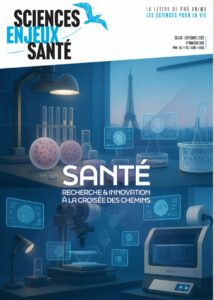
News on non-animal methods
OCTOBER 20 - 24, 2025
NEWS, REPORTS & POSITION STATEMENTS
1. Nature commentary on NAMs : Alternatives to animal testing are the future
A new commentary has been published in the high impact journal Nature entitled “Alternatives to animal testing are the future — it’s time that journals, funders and scientists embrace them”. The article showcases the rise of novel alternative methods (NAMs) in biomedical research over the past 20 years, but also the fact that those using innovative approaches still face resistance from some quarters.
“Like any tool in research, NAMs bring their own challenges. But they offer a route to more ethical research and better predictions about how humans will respond to treatments. We encourage many more members of the scientific community worldwide to embrace them.”
Read the full article on Linkedin
2. Biopharma’s agentic AI moment
Owkin, an AI company focused on unraveling the complexity of biology and advancing new diagnostics and therapies, partnered with STAT Brand Studio on a Pulse Check report to survey more than 200 executives and researchers in the U.S. and Europe about agentic AI.
The survey reveals a biopharma industry at an agentic AI inflection point, characterized by cautious optimism and strategic positioning rather than wholesale adoption. While 66% of organizations view implementation as important or very important, this enthusiasm is tempered by significant barriers, particularly around data protection and trust in results.
3. Using human organoids to understand the biology of exposomes
Organoids are promising in vitro models that can be used to mimic human physiology and provide accurate information on how human cells in their native-like tissue microenvironment are affected by exposomes including pollutants, toxic metal ions, drugs, viruses, and even microplastics.
Genetic engineering & Biotechnology News science journalists explore how organoid technology is advancing exposomics and immunology research, and how emerging AI tools are enhancing downstream data analysis, paving the way for organoids to make a larger translational impact on biomedical innovations.
Read the full article in GENBio
4. NC3Rs latest report on the outcomes of the first UK funding call for infrastructure
The NC3Rs has published the report highlighting the impacts of the first UK funding call for NAMs infrastructure to strengthen national capabilities, with the participation of the Department for Science, Innovation and Technology (DSIT).
Eleven awards totalling £3.95M were made through this competitive call, enabling national facilities to be established for stem cells, bioprinting, O&OOC systems, providing greater access to these technologies as well as training opportunities across the UK. Since the awards were made in September 2024, more than 1,800 researchers have benefited from the facilities and over 120 academic and industry partnerships are helping to embed the technologies into research practice.
Read more and download the report
5. Breaking the validation paradox : Why NAMs fail where science succeeds
Following the UK NAMs roadmap recently published and that represents a significant step forward in regulatory evolution, Baran Szczepan, Chief Scientific Officer at VeriSIM Life shared a reflection statement on the reasons why so many New Approach Methodologies (NAMs) appear successful during their validation phase, yet still fail when it comes time for full‑deployment.
Recalling that validation requirements remain a critical barrier to implementation, and that the path forward requires collective effort across sectors, Szczepan refers to the recent NC3Rs / MHRA / ABPI workshop report : “Incorporating NAMs into medicines development : Insights from regulators, industry and academia”.
TOOLS, PLATFORMS, CALLS
6. Open Call Horizon Europe 2026 : Integrating NAMs to advance biomedical research and regulatory testing
The final instalment for the Health Cluster under Horizon Europe (2021 – 2027) has been published, aiming to address the remaining gaps, emerging research needs, and future challenges identified in the programme’s second strategic plan, covering 2025 – 2027, and aligning with the European Commission’s Political Guidelines for 2024 – 2029. The time is ripe to go one step further to deliver validated NAMs solutions that can be taken up by industry and accepted by the regulators for the safety assessment of chemicals.
To address this, the section “Developing and using new tools, technologies and digital solutions for a healthy society” proposes 4 calls : Integrating New Approach Methodologies (NAMs) to advance biomedical research and regulatory testing. Deadline : 16 April 2026 ; Total budget : €50 million. The 3 other calls of the section are : Development of predictive biomarkers of disease progression and treatment response by using AI methodologies ; Advancing bio-printing of living cells for regenerative medicine ; and Virtual Human Twins (VHTs) for integrated clinical decision support in prevention and diagnosis.
See the full Horizon Europe — Work Programme 2026 – 2027 — Health, and find out more on the calls
7. Draft text of IHI call 12
The draft text of Innovative Health Initiative (IHI) call 12 is now available on the future opportunities page of the IHI website. The IHI plans to launch the call early next year, but is publishing the draft topics now to give applicants additional time to prepare a strong proposal and join or build a winning consortium.
The call text is currently under consultation with the States’ Representatives Group (SRG) and Science and Innovation Panel (SIP). The IHI strongly encourages anyone interested in the call to start preparing a proposal and get networking with potential partners. IHI will hold info sessions on call early next year, covering the content, IHI rules and procedures, and the financial aspects of the proposal.
8. FDA’s CDER Guidance for streamlined non-clinical drug development and NAMs application
On October 8, 2025, the U.S. Food and Drug Administration (FDA) Center for Drug Evaluation and Research (CDER) released a new table to support the use of new approach methodologies (NAMs) and reduction of animal use.
The table contains an inventory of drug development contexts for which CDER is open to a streamlined nonclinical program. Streamlined nonclinical programs include but are not limited to reduced sample size, reduced number of species tested, and NAMs use. The table provides general information ; sponsors should consult guidance documents and appropriate FDA review divisions for more information. The FDA regularly revises existing guidance documents and publishes new guidance documents. This table will be updated as new information becomes available.
Read more and access the inventory
SCIENTIFIC DISCOVERIES & PROTOCOLS
9. Human assembloid of blood vessel organoids with pancreatic islets
Pancreatic islet transplantation is a promising treatment strategy for type 1 diabetes patients ; however, there are still major challenges to overcome, including vascularization. Despite a substantial need to understand the islet graft decline observed in patients 5 – 10 years post transplantation, clinical translation remains challenging, probably because of species-specific features and the lack of in vitro vascularized models.
In a new publication, researchers from the CEA in Grenoble (France) report results of a human assembloid composed of self-organizing 3D blood vessel organoids (BVOs) with human pancreatic islets. The authors demonstrate that co-culture of islets and BVOs ex vivo leads to an auto-organized assembloid and improves insulin secretion over time on 5 independent human islet donors. Taken together, this study could accelerate our understanding of type 1 diabetes and facilitate therapeutic development for type 1 diabetes patients.
Read the publication in Cell Reports
10. Long-term 3D culture of epithelial organoids with invasin-functionalized hydrogels
Hubrecht researchers introduce a biomaterial by incorporating the integrin-binding domain of Yersinia Invasin protein into polyisocyanide (PIC)hydrogels, creating a multivalent 3D Invasin environment for long-term culture of tissue stem cell (TSC)-derived epithelial organoids.
Unlike matrigel/Basement Membrane Extract (BME), this system is fully defined, animal-free, and cost-effective. Additionally, PIC hydrogels offer significant advantages due to their reversible thermoresponsive properties, making the gels easy to handle and adaptable for organoid culture. The integration of 2D and 3D Invasin-based cultures provides a robust Matrigel/BME alternative, enhancing organoid accessibility and enabling automation, validation, and standardization of research in academia and industry.
Read more in Proceedings of the National Academy of Sciences (PNAS)
11. Beyond QSARs : Quantitative Knowledge-Activity Relationships (QKARs) for enhanced drug toxicity prediction
The field of risk assessment and drug safety has been traditionally dominated by Quantitative Structure-Activity Relationships (QSARs), which predict toxicological effects based solely on chemical structure. Advances in artificial intelligence (AI), especially embedding generative AI, provide an opportunity to enhance toxicity predictions by leveraging broader chemical knowledge and its integration with structural data.
In a new study, the authors propose a novel framework, Quantitative Knowledge-Activity Relationships (QKARs), which predict toxicity using domain-specific knowledge. They developed QKAR models for two drug toxicity endpoints, drug-induced liver injury (DILI) and drug-induced cardiotoxicity (DICT), using three different knowledge representations with varying levels of knowledge. Outperforming QSARs for DILI and DICT, the results demonstrate the potential of QKARs as a robust alternative to QSARs, offering additional opportunities in drug toxicity assessments by leveraging both domain-specific knowledge and structural data.
Read more in Toxicological Sciences


